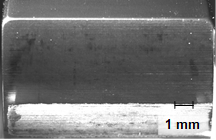Research Topic
| Short Title | Durability of DLC coatings |
| Start of Project | Q2/2020 |
| Funding | FVA-Nr. 585 III, IGF-Nr. 21103 N/1 Research Association for Drive Technology e.V., FVA Federal Ministry for Economic Affairs and Climate Action, BMWK |
| Project Partner | Institut für Oberflächentechnik (IOT), RWTH Aachen |
| Contact | Dr.-Ing. T. Lohner |
Project Description
The requirements on technical systems in terms of energy efficiency and power density are constantly increasing. The sectors of mobility and plant construction in particular are determined by the topics of sustainability and emission reduction. Thereby, increasing the energy efficiency of drive trains in machines makes a decisive contribution.
The power density of the machine elements in powertrains, such as gears, connecting rod bearings, cam tappets and piston rings, is significantly influenced by the tribological system properties of friction and wear. One way to achieve increased energy efficiency while simultaneously increasing the power density without fundamental design modifications is to coat functional surfaces using amorphous carbon coatings, so-called diamond-like carbon (DLC) coatings. Research results with DLC-coated gears show a significant increase in flank load capacity compared to uncoated gears with regard to the types of damage pitting, micropitting, wear and seizure.
The industrial use of DLC-coated gears has so far been limited by the insufficient durability of the composite material consisting of the coating and the substrate. For this purpose, Figure 1 shows an optical scan of a DLC-coated tooth flank, on which the coating has been removed in the tooth root flank area. In order to realize the full potential of DLC coated gears in industrial applications, an increase in the durability of DLC coated gears is required. Within the project, the interactions of the decisive influencing variables, such as e.g. lubricants, substrate materials, pre-treatment processes, coating parameters and gear geometry are systematically examined. The aim is the practicability for the industrial use of the tribological potential of DLC-coated gears in the drive train. Therefore, an increased and reliable adhesion between the component and the coating is required.
